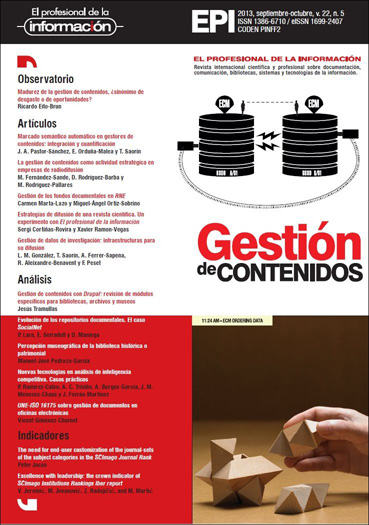Automatic semantic markup in content management systems: integration and quantification
DOI:
https://doi.org/10.3145/epi.2013.sep.02Keywords:
Semantic web, Linked data, Semantic markup, Content management systems, Wordpress, RDFaCE-Lite, Sindice, Universities, Webometrics.Abstract
A general overview of the different semantic markup formats and the existing technologies to incorporate explicit semantic information (microformats, microdata and RDFa) is provided. Services are described that automate, to some extent, semantic annotation processes (Sindice, Calais, AlchemyAPI and DBPedia Spotlight), while characterizing the complete cycle of this process in a particular CMS (Wordpress) using a specialized plugin (RDFaCE-Lite). Finally, in order to quantify the creation and connectivity of semantically marked content on the Web, the space formed by all Spanish universities (and a selection of 25 international institutions) is analysed with Sindice . Semantic page count and visibility indicators (inlinks, outlinks, internal and third party) are calculated for the sample. The results indicate limited presence of semantically marked content in the universities and highly isolated web visibility of this content.
Downloads
Downloads
Published
How to Cite
Issue
Section
License
Dissemination conditions of the articles once they are published
Authors can freely disseminate their articles on websites, social networks and repositories
However, the following conditions must be respected:
- Only the editorial version should be made public. Please do not publish preprints, postprints or proofs.
- Along with this copy, a specific mention of the publication in which the text has appeared must be included, also adding a clickable link to the URL: http://www.profesionaldelainformacion.com
- Only the final editorial version should be made public. Please do not publish preprints, postprints or proofs.
- Along with that copy, a specific mention of the publication in which the text has appeared must be included, also adding a clickable link to the URL: http://revista.profesionaldelainformacion.com
Profesional de la información journal offers the articles in open access with a Creative Commons BY license.




